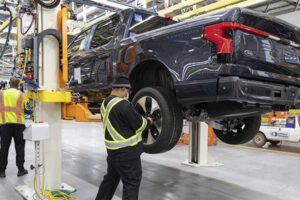Ford Motor Company has recently announced a significant decrease in the production of its F-150 Lightning electric pickup truck. This decision, made public on January 19, signals a major shift in the company’s approach to the electric vehicle (EV) market.
Despite a 55% increase in F-150 Lightning sales from the previous year, Ford is recalibrating its production to better align with current market demands and its broader business objectives.
“We are taking advantage of our manufacturing flexibility to offer customers choices while balancing our growth and profitability,” said Ford CEO Jim Farley in a statement.
Production Adjustment and Workforce Impact
The scaling back of the F-150 Lightning production at the Michigan Rouge Electric Vehicle Center is set to begin on April 1, transitioning to a single-shift operation.
This move is part of Ford’s larger strategy to balance growth with profitability.
In response to this change, approximately 700 employees will be transferred to the Michigan Assembly Plant to ramp up the production of gas-powered models such as the Ford Bronco SUV and Ranger pickup.

Ford said it would double its production capacity for the F-150 Lightning from 40,000 units per year to 80,000 electric pickup trucks by 2024.
Ford’s decision mirrors a similar trend observed in other automakers, including General Motors, which also postponed the expansion of its Chevrolet Silverado EV production.
The overall growth of the EV market, although positive, has not met the initial expectations of many industry experts. Additionally, the financial aspect plays a crucial role.
Ford reported a significant loss on each EV sold in the previous quarter, highlighting the economic challenges inherent in the EV sector.
This contrasts with the more profitable gas-powered vehicles, leading to a strategic reassessment of Ford’s EV initiatives.
Pricing Dynamics and Industry Comparison
The F-150 Lightning faces its own set of challenges in the market, primarily related to its pricing.
The truck’s starting price, even after federal EV tax credits, remains significantly higher than its gasoline counterparts.
This price factor, coupled with production costs, has necessitated a reevaluation of Ford’s approach to EVs.
Interestingly, Ford’s cautious stance contrasts with Stellantis CEO Carlos Tavares’s commitment to accelerating EV production, underlining the diverse strategies within the industry.
A Cautious Path Forward
The reduction in F-150 Lightning production, amidst shifting industry dynamics, underscores the complex balancing act facing automakers in the EV transition.
While the commitment to electric vehicles is unwavering, given their importance in addressing climate change, the pace and approach to this transition are becoming increasingly cautious.
Automakers like Ford are navigating through customer preferences, economic realities, and environmental responsibilities, indicating a more measured approach to the electrification of the automotive industry in the coming years.














Comments